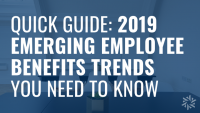Life insurance is one of the most common employer-provided benefits, but it can also be one of the most misunderstood among employees. This article covers the basics, from types of coverage to how it effectively promote it to your employees.
The Basics: Types of Life Insurance
Life insurance is divided into two categories: term and permanent.
Term life insurance
Term life insurance has a specified coverage period (“term”), but can usually be renewed or converted into a permanent policy at the end of the term. Premiums are generally affordable initially but can increase substantially when renewed.
Permanent life insurance is life-long coverage that usually includes a cash value savings component. There are many types of permanent life insurance, described below. This type of coverage has higher premiums, but offers more long-term value.
Whole life insurance
Whole life insurance is a type of permanent insurance that offers life-long coverage combined with a cash-value savings component. This type of policy has higher premiums than term life. Premiums remain constant throughout the policy and a portion is invested by the company, which becomes the cash value of the policy. Whole life insurance pays a fixed amount upon death.Universal life insurance
Universal life insurance is another type of permanent insurance policy that combines term insurance with the ability to earn interest on the cash value, paying a market rate of return. Cash value grows tax-deferred, and can be withdrawn or borrowed from the policy. It is more flexible than whole life insurance as it also allows you to change your premium payments and death benefit, within limits defined by the policy.Variable life insurance
Variable life insurance is similar to universal life insurance in terms of flexibility and an investment aspect. However, instead of simply earning interest on the accumulated cash value, policy owners have more control over how to invest that cash. The ability to invest in professionally managed investment options allows for the potential to accumulate cash value while providing death benefits protection. However, there is a greater risk for loss due to this benefit.
The Basics: Employer-Sponsored Coverage
Employer-sponsored life insurance coverage can be offered in a variety of ways. Employers can offer a term policy, permanent coverage or both. Cost-sharing also varies, as some employers cover the full cost, some require employees to pay the full premium, and others split the cost with employees.
A common scenario is an employer offering a group-term policy at no cost to the employee, with a coverage amount that is a multiple of annual salary (usually one to five times annual pay) and often has a maximum amount cap. Group-term policies often end when an employee leaves the organization (or dies), but employees may be able to convert it to a permanent policy or renew it upon leaving. This is generally an affordable plan for employers to offer, though it does not offer as much long-term value to employees as a permanent plan.
Many employers who offer such a group-term policy also offer additional voluntary life coverage options, in which the employee pays the full cost but still realizes the benefit of group rates and payroll deductions. Additional coverages offered may include:
Spouse/dependent life insurance (group-term policies only cover the employee)
Supplemental term life insurance (to elect a higher amount than the employer offers)
Supplemental permanent coverage (a whole, universal or variable life policy in addition to the term policy)
Accidental death & dismemberment (AD&D) coverage
Life Insurance and AD&D, What's the Difference?
Unlike term life insurance, AD&D policies pay out for a death only if you are killed or injured in an accident. For example:
- If you die from a heart attack or cancer, there’s no payout.
- If you die in a car crash, there’s a full payout of the policy’s face amount.
To qualify for a payout for injury, you must lose a body part or the ability to hear, see or speak. If you suffer an injury, the policy generally pays out only part of the full benefit. The exact payouts will be listed in your policy.
The Basics: Taxes
Premiums for life insurance offered by the employer are generally deductible as ordinary and necessary business expenses (unless the employer is the beneficiary of the policy). In addition, the cost of employer-provided group-term life insurance is excludable from the employees’ gross income (up to $50,000 of coverage). The plan must meet special nondiscrimination rules, however, or key employees may not be eligible to exclude the cost of their coverage from their gross income.
The Basics: Communicating Value to Employees
Though life insurance is an important asset for future financial security, many employees don’t realize its importance. Teaching employees about the value of life insurance may increase loyalty to the company as they better appreciate this benefit.
Ask employees to envision the debt and financial responsibilities that loved ones would face in the event of their death. If the employee is the primary household income, how will the family support themselves? If the employee dies and leaves behind a mortgage or substantial medical bills, who will have the burden of paying that debt? Many employees do not realize the financial benefits of a life insurance policy until they think through these issues. If you offer a permanent coverage option, also explain the value of having the cash benefit component to the policy.
Emphasize to employees that buying life insurance on their own is costly; even if your group coverage is employee-paid, you are still offering significant advantages:
Lower rates through a group policy than if buying individual coverage.
Below is a chart that highlights the premium differences between whole life and term life insurance in individual policies. Please remember that these are only estimates and that premiums are subject to change based on locality, the underwriter and individual health factors that include family history, occupational risk and hazardous hobbies.
$100,000 policy for a 50 year-old nonsmoker in good health Whole Life Male $707 per month Female $590 per month 20-year Term Life Male $115 per month Female $100 per month Generally, no medical review is required for group policies*, as opposed to individual policies where an unfavorable medical exam could disqualify the individual or trigger extremely high premiums. (Be sure to inform employees on restrictions regarding this issue, such as a requirement to enroll when first eligible to avoid a medical exam.)
*There may be required medical questions, known as an Evidence of Insurability (EOI) Form, if an employee elects an amount of coverage over the Guaranteed Issue of the policy.Convenience of payroll deductions for premiums

Educating employees on the benefits of life insurance in general and the advantages of purchasing through your group plan can help increase awareness and participation, boost loyalty, and support hiring and retention initiatives.
The Basics: Factors to Consider When Choosing Life Insurance Policies
When deciding to offer life insurance as an employee benefit, there are a number of factors to consider:
What type of coverage will you offer?
Will you offer term insurance, permanent or both?
Who will be covered (employees only, retirees, spouses, dependents)?
Note: Only employees can be covered under a group-term policy.When is coverage effective? Will there be a waiting period?
What amount of insurance will be available? How will that amount be determined (flat fee vs. multiple of salary)?
Who will pay premiums (you, employees or both)?
Will there be a minimum amount required to elect? What is the maximum coverage amount allowed?
Once you have an idea about the type of coverage you’d like to offer, Austin Benefits Group can help you find a plan that meets your needs, contact us today. Austin Benefits Group offers more than benefits consulting, check out the full range of services from the best team in benefits.



